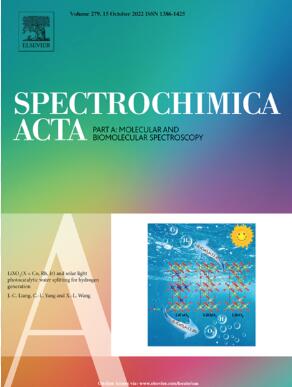One step in-situ synthesis of Cu/Mn: ZnInSe quantum dots with enhanced luminescence and environmental stability
IF 4.3
2区 化学
Q1 SPECTROSCOPY
Spectrochimica Acta Part A: Molecular and Biomolecular Spectroscopy
Pub Date : 2025-02-01
DOI:10.1016/j.saa.2025.125842
引用次数: 0
Abstract
A novel Cu/Mn: ZnInSe ternary quantum dots (QDs) was synthesized by one step in-situ hydrothermal method from low-cost inorganic salts and natural biomolecules. Based on the controlled L-cysteine capped ZnInSe QDs structure, Cu/Mn: ZnInSe QDs were synthesized by Cu and Mn co-doping. The effects of experimental variables such as ZnInSe QDs synthesis conditions and Cu/Mn doping ratio were systematically studied. The results show that the photoluminescence (PL) intensity of the co-doped ternary Cu/Mn: ZnInSe increases significantly by about 1.8 times, and the position of the fluorescence emission peak is redshifted. The mechanism of fluorescence enhancement was attributed to doped ions confined in the quantum dot lattice, providing new recombination centers for electrons and holes, and forming internal luminescent centers. The structures and morphologies of ZnInSe QDs and Cu/Mn: ZnInSe QDs have been confirmed by X-ray photoelectron spectroscopy (XPS), Fourier transform infrared spectroscopy (FTIR), transmission electron microscopy (TEM) and X-ray powder diffraction (XRD), The effects of environmental impact factor (light, temperature, pH, H2O2) of ZnInSe QDs and Cu/Mn: ZnInSe QDs were studied by measuring the change in the PL intensity. It is also found out that Cu/Mn: ZnInSe QDs exhibit good stability under visible light, as well as certain acid resistance and oxidation resistance. Especially after doping, there is a significant improvement in high-temperature resistance performance. 120 % of the PL intensity can be remained after the temperature rises to 60 °C, Whilst less than 70 % is maintained for undoped ZnInSe QDs. These results would contribute to further understanding dopant-dependent interaction, and this new class of co-doped QDs with high uniform size, enhanced luminescence and environmental stability demonstrates a promising future to be applied in white LED and bio-tag.

求助全文
约1分钟内获得全文
求助全文
来源期刊
CiteScore
8.40
自引率
11.40%
发文量
1364
审稿时长
40 days
期刊介绍:
Spectrochimica Acta, Part A: Molecular and Biomolecular Spectroscopy (SAA) is an interdisciplinary journal which spans from basic to applied aspects of optical spectroscopy in chemistry, medicine, biology, and materials science.
The journal publishes original scientific papers that feature high-quality spectroscopic data and analysis. From the broad range of optical spectroscopies, the emphasis is on electronic, vibrational or rotational spectra of molecules, rather than on spectroscopy based on magnetic moments.
Criteria for publication in SAA are novelty, uniqueness, and outstanding quality. Routine applications of spectroscopic techniques and computational methods are not appropriate.
Topics of particular interest of Spectrochimica Acta Part A include, but are not limited to:
Spectroscopy and dynamics of bioanalytical, biomedical, environmental, and atmospheric sciences,
Novel experimental techniques or instrumentation for molecular spectroscopy,
Novel theoretical and computational methods,
Novel applications in photochemistry and photobiology,
Novel interpretational approaches as well as advances in data analysis based on electronic or vibrational spectroscopy.

 求助内容:
求助内容: 应助结果提醒方式:
应助结果提醒方式:


